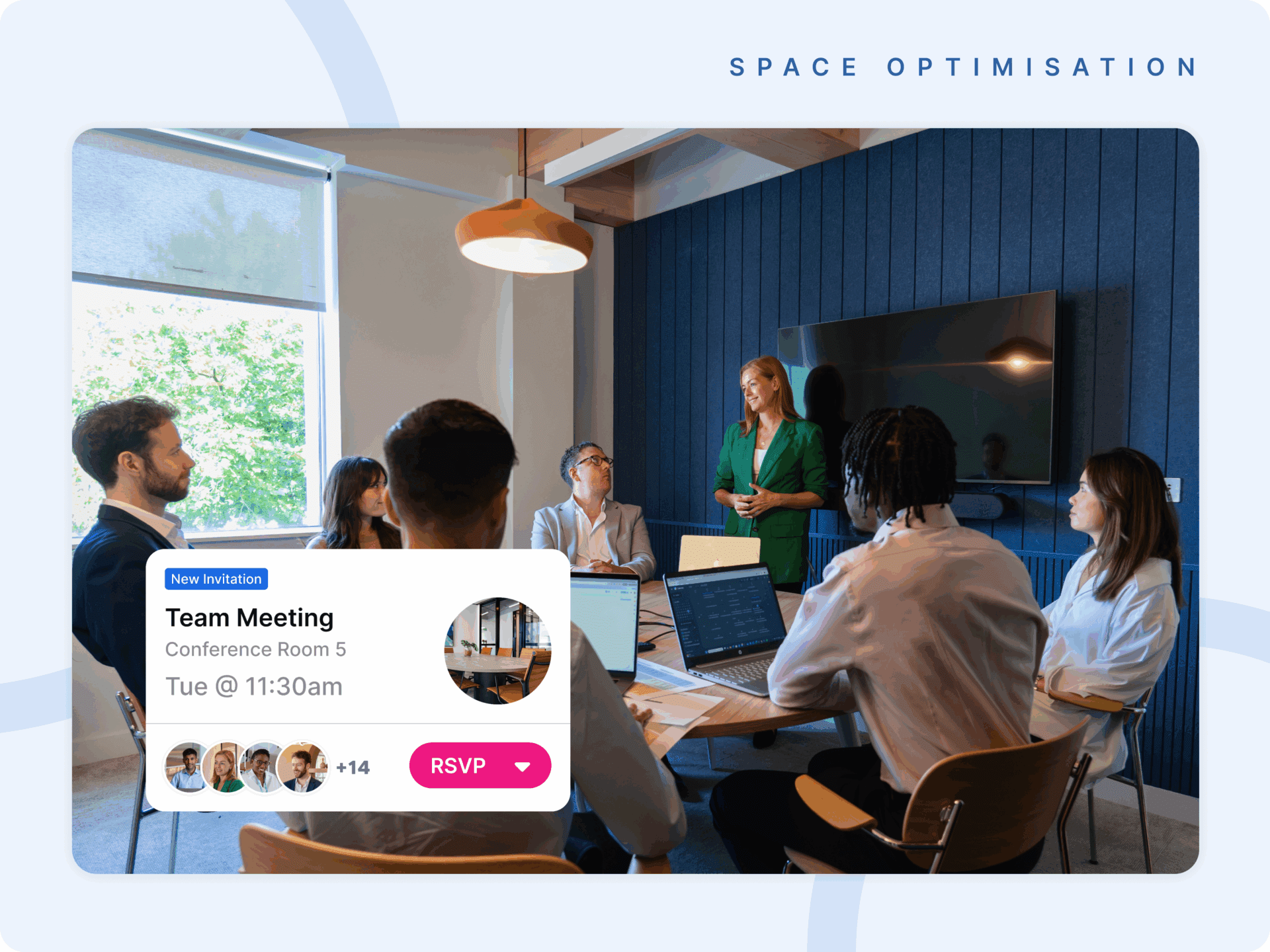If your teams are making a transition from remote working to hybrid working, welcome them back to the office. Think effective organizational communication among in-person or remote employees, improved meeting ideas, and enhanced employee well-being, among other things.
Whether you are the employer, a manager, or an employee, getting back to the office is touchy. Since every member of your organization needs time to adjust to this change, you can make the transition smoother using these tips:
1. Prepare Your Office Building
There’s no better way to say “welcome back to work” than with a refreshed and appealing atmosphere. Organize workspaces, arrange communal areas to encourage interaction, and consider updating any outdated tools or equipment, such as chairs or desks, to make your employees feel valued and comfortable as they return to the office. Small enhancements show that you’re committed to creating an inviting and supportive environment.
2. Enhance Your Organizational Communication Channels
Proper communication ensures you experience a smooth transition from the onset because it keeps everyone informed. Make clear communication an essential part of your planning process by creating communication processes across all your business channels to ensure every employee receives their intended message.
Some excellent avenues to pass information to your employees include:
- Company announcements
- Email notifications
- Workplace app
Don’t use one channel. Instead, use every medium you have and consider integration solutions like Slack to improve your communication processes.
For instance, notify your employees of your plans beforehand to help them prepare. Parents especially need time to plan for daycare, and employees in distant remote locations might need to plan for travel back to their homes.
In your message, include the requirements your employees need to have before they are back in the office. For example, include:
- The introduction of flexibility within the workplace
- The employees expected to be in the office
- The employees allowed to work remotely
- Remote working guidelines like the available desk booking software solution
- The health guidelines for safety, like the need to wear masks at all times
- The safety health precautions like proof of vaccination for all employees coming back to work
- New practices you plan to implement, whether to improve office efficiency or to safeguard against health risks
Ensure your message is comprehensive yet easy to understand and follow. Also, include a contact your employees can use if they have any additional questions or concerns they need addressing.
3. Be Flexible
Many employees have settled into the remote working environment. The flexibility of setting individual work schedules from home has made remote workers more productive than office workers.
Therefore, going from remote working routines to a fixed working schedule is not ideal for many employees. Adopting a flexible approach to work is sure to make your employees more comfortable as they come back to the office.
Be Patient: Instead of making it mandatory for all employees to return to work, give them time and phase out their return.
Collect Feedback: Make sure this works for them and ask how they feel about it and what they need to help with the transition. Take suggestions from your employees with a survey on how you can better accommodate their preferences.
4. Get To Know What Your Employees Want
Don’t assume your employees are mentally and emotionally prepared to be in the office. They might have concerns that never cross your mind, which you can mitigate to enhance your reopening experience further. As such, find out whether:
- Hybrid workers prefer to be in the office on a specific day of the week
- Your employees feel comfortable returning to the office, or if specific issues make them anxious
- They think they can carry out their duties efficiently once they are back to work
- They need any specific tools, technology, or equipment to make their work more productive
- Your implemented safety guidelines and protocols make them feel safe, or if there are areas to improve on
5. Welcome Gifts For Your Employees
Personalized surprise gifts on every employee’s desk are quite the existential way of saying “welcome back to work.” For instance, a working mum might prefer a daycare money voucher while a health and fitness fanatic might prefer a well-being hamper. The more practical and personal the gift, the more your employees will feel your appreciation. Gift ideas to use are:
- Desk or office plants
- Nutritious snack boxes
- Chocolate, brownies, or donut boxes
- After-work activity service vouchers
- Self-care hampers with things like journals and nutrition tips
6. Plan For Team Building On The First Day Back
This is an excellent yet fun idea to get your employees back into the spirit of teamwork. For instance, an office scavenger hunt is the perfect team-building activity to work on problem-solving skills while working in a team.
You can implement a regular “Kadence” of team-building activities into your employees’ schedule to keep encouraging them to work as a team long after their first day back to work. Events can encourage people back to the office, because they offer opportunities to connect with colleagues outside of their team. A weekly agenda of team activities can keep momentum going.
7. Prepare For The First Meeting
When done correctly, meetings enhance productivity. Make your first meeting a little better by creating a space where your team can share their voice and ideas. Include coffee, donuts, and other treats in your weekly meetings.
How To Prepare: Start simple with icebreakers, interact with your team, and then set the tone for the meeting. Ensure the meeting room is big enough to accommodate everyone while maintaining a social distance. Install technology like a microphone and a TV screen to help virtually bring remote workers into the meeting.
Encourage Engagement: Introduce your new working strategy and plan for the year’s first quarter. Make your objectives fun and tie them to a reward program to increase employee motivation. Allow creative ideas and discussions from your team members.
Give A Time Schedule: Create a timeline for your plan to ensure you meet deadlines. Use a whiteboard if you must to explain your ideas and strategies. Introduce a goal-tracking system where you track your team’s success once they achieve the goals on your board. Then introduce a reward for each win or milestone achieved for your entire team.
8. Create A Plan For Your Remote Workers
Accommodating your remote or hybrid workers in your welcome-back activities is critical to ensuring you remain inclusive. As mentioned, technology is a great way to bring your remote workers to the office regardless of their location. Therefore:
- Include helpful technology in the office and ensure your remote workers have the right technology to communicate with your office.
- Use your communication channels to keep remote workers updated with daily work processes.
- Send them their gifts to their designated locations and provide the flexibility to join your co-working spaces.
- Introduce social activities between remote cross-teams to keep them friendly to the working environment and increase teamwork.
As an employer, check on your remote workers more often than you do with your in-person employees. It is much harder to notice signs like burnout in remote workers. Still, you can combat these issues by regularly getting feedback through your hybrid model, personal observation, and regular talks.
9. Allow Your Workers To Engage With Each Other
Allowing your team to be more interactive means they might feel more motivated and less stressed to be back at work, thus increasing their engagement and productivity levels. This also encourages a healthy flow of teamwork and ideas. Therefore, allow on and off interactions throughout the day but clarify that they must meet deadlines.
10. Onboarding New Hires
Certain dos and don’ts make new hires feel less anxious when they first meet their employers. So, when your new hires arrive at your office, please introduce yourself, your company, and what you do, then take them on a tour around your office building.
If you have new hires for different departments or teams, ensure you introduce them to the people in their group and then set a meeting time for a one-on-one meeting with their immediate supervisor. Once you’ve given them all your expectations and company rules, allow them to interact with other employees in the office.




